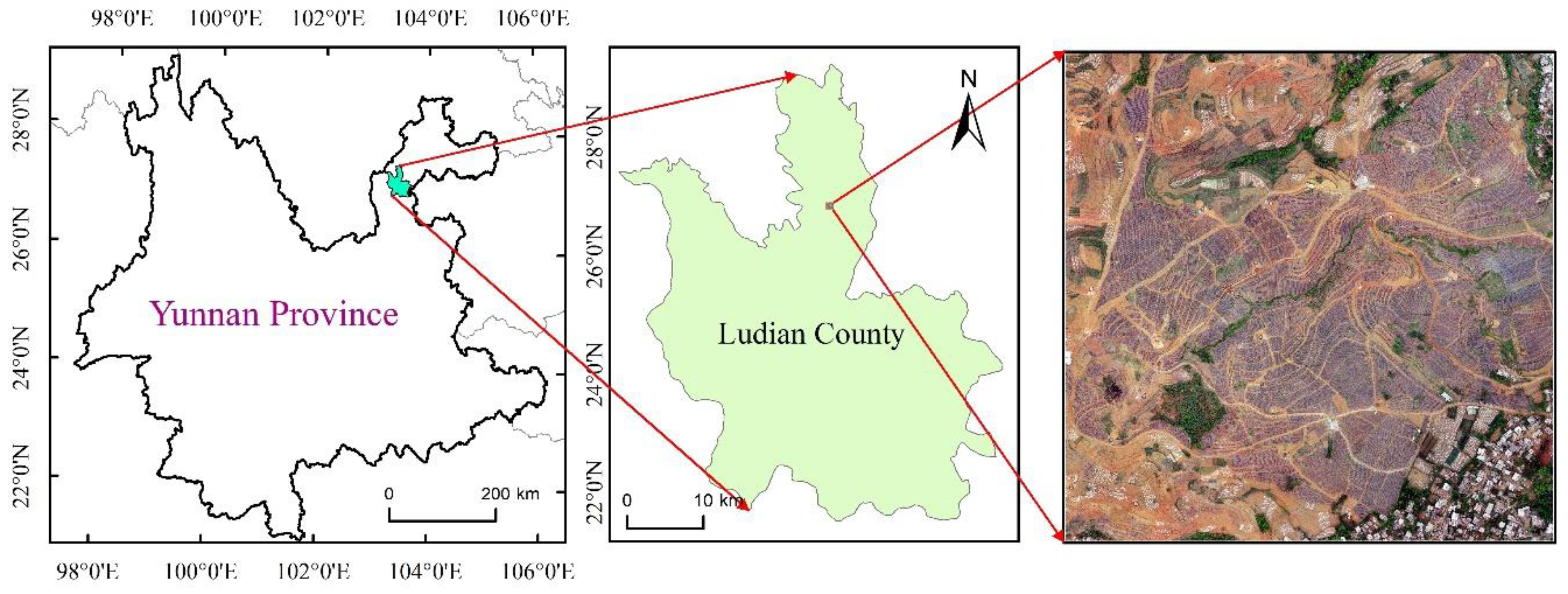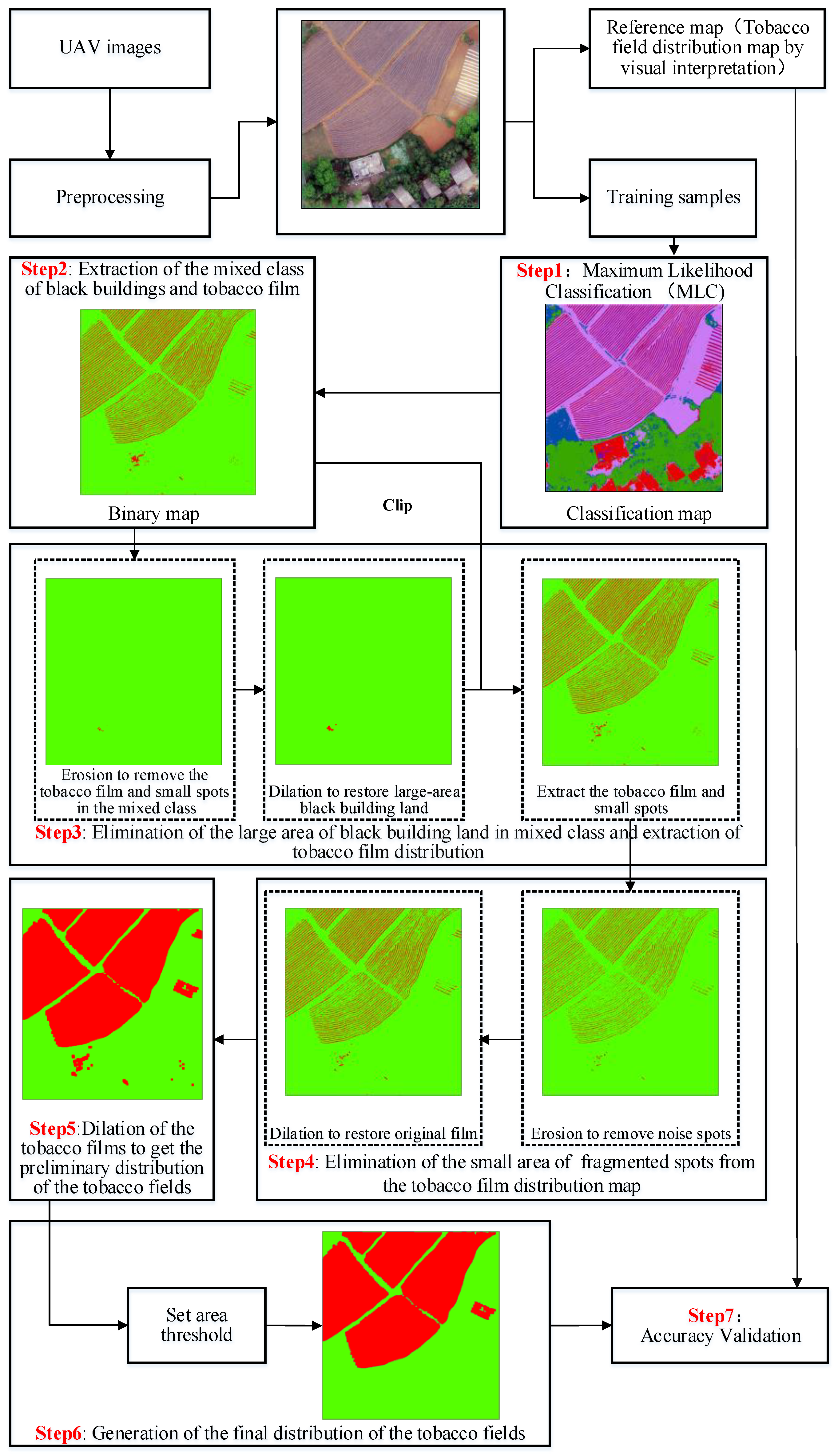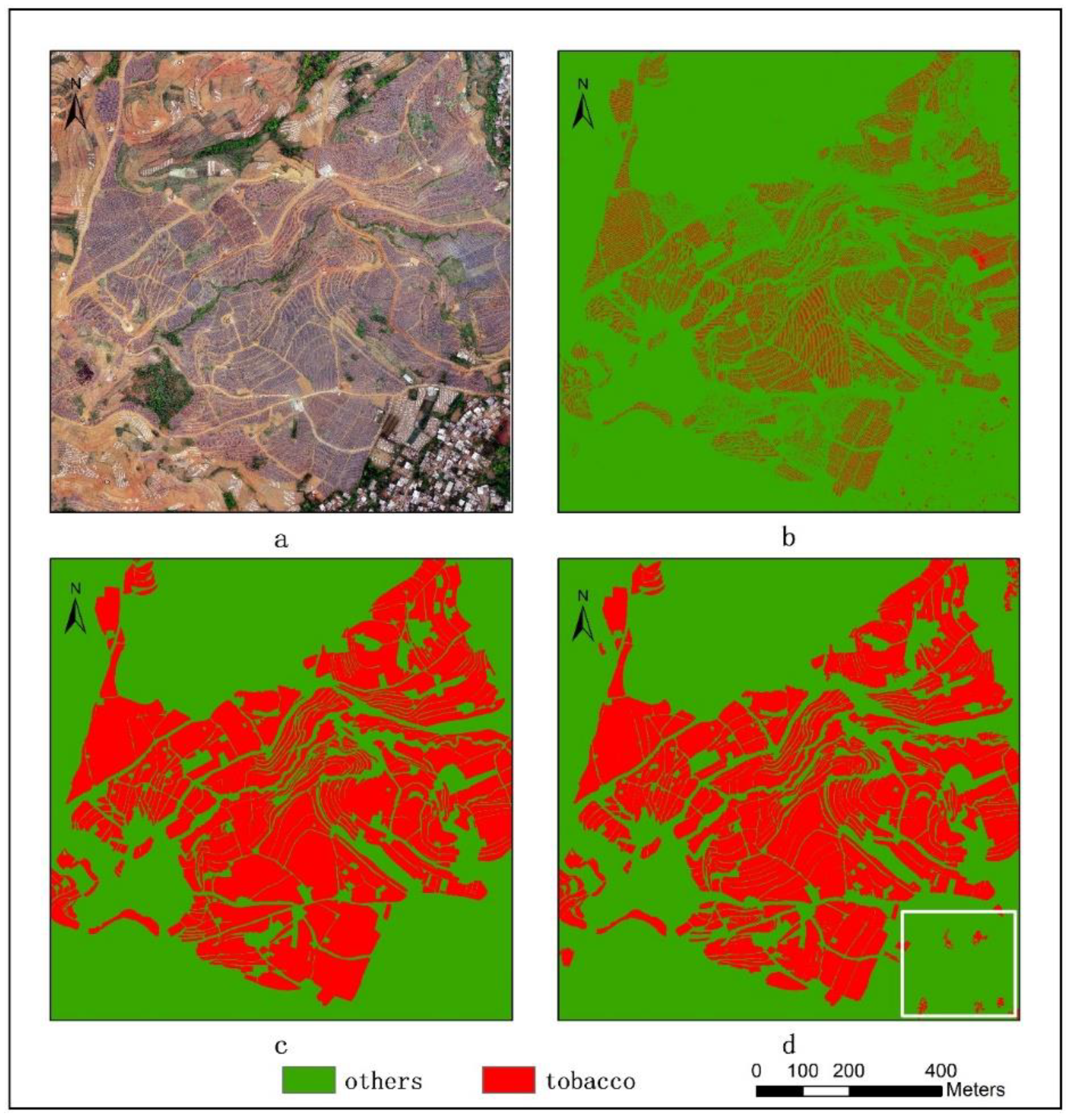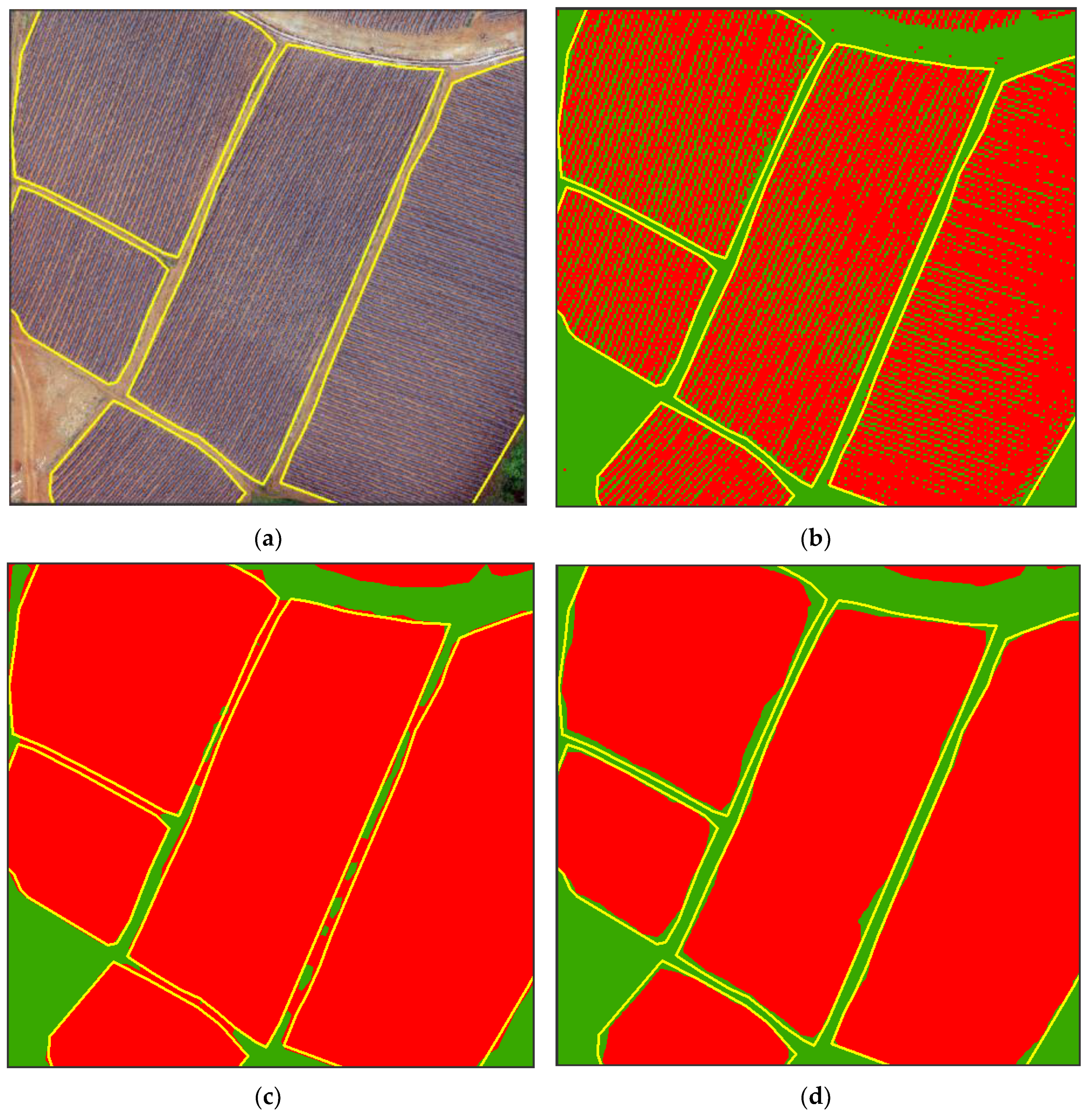Mapping Tobacco Fields Using UAV RGB Images
Abstract
1. Introduction
2. Study Area and Data
3. Methodology
- Supervision classification: the types of land cover in the study area were first classified into nine categories: woodland, grassland, dirt road, facilities land, bare cultivated land, white building, black building, white plastic film (spring maize film) and black plastic film (tobacco film) by using the maximum likelihood classification algorithm. The training samples were selected by visual interpretation (Table 2).
- Extraction of the mixed class of black buildings and tobacco film: black buildings were easily confused with tobacco film; therefore, based on the land cover map produced in the first step, we recoded the tobacco film and the black buildings as 1 (refers to the mixed class of black building and black film), and, then, we recoded the other land cover types as 0.
- Elimination of the large area of black building land in the mixed class and extraction of the tobacco film distribution: by observing the image, we can see that the width of a single tobacco film is relatively narrow (usually less than 1 m), far less than the width of the buildings. Thus, we used the erosion and dilation algorithms of image morphology to remove the large area of black buildings in the mixed class. First, erosion was carried out. Assuming that the maximum width covered by a row of film is Bmax, the GSD of the image is S, a numerical upwarding operation is T, the core size of the erosion is K, the element value in the core is 1, and the erosion width is set as . K = 0 refers to when no process in the elimination of the large area of black buildings in the mixed class and extraction of the tobacco film distribution is made. After erosion, the tobacco film and other small spots in the mixed class were eliminated, and the edges of the black buildings were corroded, which resulted in the reduction of the scope of the black building land. Then, we carried out the dilation algorithm on the corroded black building land. The expanded core size is consistent with the erosion core size, and the element value in the core is set as 1. At this point, the distribution map of the large area of black buildings has been obtained. Then, we masked the large area of buildings from the binary map produced in the second step to obtain the distribution of the tobacco films that still included a small area of buildings (regarded as noise):
- Elimination of the small area of fragmented spots from the tobacco film distribution map: after the previous operation, the binary map mainly contained the tobacco film and some fragmented spots. These fragmented spots are the commission errors because other land cover types were mistakenly classified as tobacco film or as black buildings during the process of supervised classification. We carried out erosion to remove them. Assuming that the minimum width covered by a row tobacco film is Bmin, the GSD of the image is S, and the core size of the erosion is . = 0 refers to when no process in the elimination of the small area of fragmented spots from the tobacco film distribution map is made. is a numerical upwarding operation, the element value in the core is 1, and the erosion width is set as . After erosion, the edges of the tobacco films were also corroded although the fragmented spots were removed. Thus, we carried out the dilation algorithm on the corroded tobacco films to restore the original tobacco film size. The expanded core size is consistent with the erosion core size, and the element value in the core is set as 1:
- Dilation of the tobacco films to get the preliminary distribution of the tobacco fields: assuming that the maximum spacing between adjacent films is Dmax, the GSD of the image is S, the size of the expanded core is , is a numerical upwarding operation, and the element value in the core is 1. After the dilation operation, tobacco films were merged into tobacco fields:
- Generation of the final distribution of the tobacco fields: after a series of dilation and erosion operations, the land cover types on the binary map were only the flue-cured tobacco fields and some black building pixels that are not eliminated; however, the area of the black buildings was far smaller than the area of the flue-cured tobacco field. By setting an area threshold of the spots, the black building spots were removed, and the final distribution map of the flue-cured tobacco fields was obtained. In this paper, the area threshold was set as 200 m2.
- Accuracy validation: we digitalized the fields of flue-cured tobacco in the study area by visual interpretation, and we used them as a reference to assess the accuracy of the flue-cured tobacco distribution map produced by the automatic identification method proposed in this paper.
4. Results
5. Discussion
5.1. The Influence of the GSD of the Image on Mapping Tobacco Fields
5.2. Potential Improvements on the Proposed Tobacco Mapping Method
5.3. Deficiencies in This Study and Future Improvements
6. Conclusions
Author Contributions
Funding
Conflicts of Interest
References
- Zhang, J.; Ou, J.X.; Bai, C.X. Tobacco smoking in China: Prevalence, disease burden, challenges and future strategies. Respirology 2011, 16, 1165–1172. [Google Scholar] [CrossRef] [PubMed]
- National Bureau of Statistics of China. The 2017 China Statistical yearbook. China Statistics Press. Available online: http://www.stats.gov.cn/ (accessed on 11 June 2018).
- Mcnairn, H.; Brisco, B. The application of C-band polarimetric SAR for agriculture: A review. Can. J. Remote Sens. 2004, 30, 525–542. [Google Scholar] [CrossRef]
- Kuenzer, C.; Knauer, K. Remote sensing of rice crop areas—A review. Int. J. Remote Sens. 2013, 34, 2101–2139. [Google Scholar] [CrossRef]
- Wardlow, B.D.; Egbert, S.L.; Kastens, J.H. Analysis of time-series MODIS 250 m vegetation index data for crop classification in the U.S. Central Great Plains. Remote Sens. Environ. 2007, 108, 290–310. [Google Scholar] [CrossRef]
- Lobell, D.B.; Asner, G.P. Cropland distributions from temporal unmixing of MODIS data. Remote Sens. Environ. 2004, 93, 412–422. [Google Scholar] [CrossRef]
- Sun, P.; Zhang, J.; Zhu, X.; Pan, Y.; Liu, H. A highly efficient temporal-spatial probability synthesized model from multi-temporal remote sensing for paddy rice identification. Eur. J. Remote Sens. 2017, 50, 98–110. [Google Scholar] [CrossRef]
- Murwira, A. Mapping maize, tobacco and soyabean fields in large-scale commercial farms of Zimbabwe based on multitemporal NDVI images in Maxent. Can. J. Remote Sens. 2014, 40, 396–405. [Google Scholar] [CrossRef]
- Wang, Z.; Chen, Y.; Mo, J.; Wang, X. Recognition of flue-cured tobacco crop based on spectral characteristics extracted from HJ-1 remote sensing images. Tob. Sci. Technol. 2014, 1, 72–76. [Google Scholar] [CrossRef]
- Peng, G.; Lei, D.; Cui, W.; Tao, M.; Wei, S. Remote sensing monitoring of tobacco field based on phenological characteristics and time series image—A case study of Chengjiang County, Yunnan Province, China. Chin. Geogr. Sci. 2009, 19, 186–193. [Google Scholar] [CrossRef]
- Maguranyanga, C.; Murwira, A.; Sibanda, M. Distinguishing maize, soyabean and tobacco fields using temporal MODIS 16 day NDVI images in the large scale commercial farming areas of Zimbabwe. J. Indian Soc. Remote 2015, 43, 79–87. [Google Scholar] [CrossRef]
- Xin, M.; Weihong, C.; Xuexia, Z.; Na, Z.; Zhenguo, N. Monitoring of tobacco planted acreage based on multiple remote sensing sources. IGARSS 2006, 668–670. [Google Scholar] [CrossRef]
- Xiang, H.; Tian, L. Development of a low-cost agricultural remote sensing system based on an autonomous unmanned aerial vehicle (UAV). Biosyst. Eng. 2011, 108, 174–190. [Google Scholar] [CrossRef]
- Zhang, C. The application of small unmanned aerial systems for precision agriculture: A review. Precis. Agric. 2012, 13, 693–712. [Google Scholar] [CrossRef]
- Jorge, T.S.; Francisca, L.G.; Isabel, D.C.A.; Manuel, P.B.J. Configuration and specifications of an unmanned aerial vehicle (UAV) for early site specific weed management. PLoS ONE 2013, 8, e58210. [Google Scholar] [CrossRef]
- Hunt, E.R.J.; Hively, W.D.; Fujikawa, S.J.; Linden, D.S.; Daughtry, C.S.T.; Mccarty, G.W. Acquisition of NIR-green-blue digital photographs from unmanned aircraft for crop monitoring. Remote Sens. 2010, 2, 290–305. [Google Scholar] [CrossRef]
- Lelong, C.C.D.; Burger, P.; Jubelin, G.; Roux, B.; Labbé, S.; Baret, F. Assessment of unmanned aerial vehicles imagery for quantitative monitoring of wheat crop in small plots. Sensors 2008, 8, 3557–3585. [Google Scholar] [CrossRef]
- Salamí, E.; Barrado, C.; Pastor, E. UAV flight experiments applied to the remote sensing of vegetated areas. Remote Sens. 2014, 6, 11051–11081. [Google Scholar] [CrossRef]
- Zarco-Tejada, P.J.; Diaz-Varela, R.; Angileri, V.; Loudjani, P. Tree height quantification using very high resolution imagery acquired from an unmanned aerial vehicle (UAV) and automatic 3D photo-reconstruction methods. Eur. J. Agron. 2014, 55, 89–99. [Google Scholar] [CrossRef]
- Sugiura, R.; Noguchi, N.; Ishii, K. Remote-sensing technology for vegetation monitoring using an unmanned helicopter. Biosyst. Eng. 2005, 90, 369–379. [Google Scholar] [CrossRef]
- Liu, H.; Zhang, J.; Pan, Y.; Shuai, G.; Zhu, X.; Zhu, S. An efficient approach based on UAV orthographic imagery to map paddy with support of field-level canopy height from point cloud data. IEEE J. Stars 2018, PP, 1–13. [Google Scholar] [CrossRef]
- Turner, D.; Lucieer, A.; Watson, C.S. Development of an unmanned aerial vehicle (UAV) for hyper-resolution vineyard mapping based on visible, multispectral and thermal imagery. In Proceedings of the 34th International symposium on remote sensing of environment, Sydney, Australia, 10–15 April 2011. [Google Scholar]
- D’Oleireoltmanns, S.; Marzolff, I.; Peter, K.D.; Ries, J.B. Unmanned aerial vehicle (UAV) for monitoring soil erosion in Morocco. Remote Sens. 2012, 4, 3390–3416. [Google Scholar] [CrossRef]
- Su, T.C.; Chou, H.T. Application of multispectral sensors carried on unmanned aerial vehicle (UAV) to trophic state mapping of small reservoirs: A case study of Tain-Pu Reservoir in Kinmen, Taiwan. Remote Sens. 2015, 7, 10078–10097. [Google Scholar] [CrossRef]
- Iv, G.P.J.; Pearlstine, L.G.; Percival, H.F. An assessment of small unmanned aerial vehicles for wildlife research. Wildl. Soc. 2006, 34, 750–758. [Google Scholar] [CrossRef]
- Hodgson, A.; Kelly, N.; Peel, D. Unmanned aerial vehicles (UAVs) for surveying marine fauna: A dugong case study. PLoS ONE 2013, 8, e79556. [Google Scholar] [CrossRef]
- Fernández-Hernandez, J.; González-Aguilera, D.; Rodríguez-Gonzálvez, P.; Mancera-Taboada, J. Image-based modelling from unmanned aerial vehicle (UAV) photogrammetry: An effective, low-cost tool for archaeological applications. Archaeometry 2015, 57, 128–145. [Google Scholar] [CrossRef]
- Hasituya, C.Z. Mapping plastic-mulched farmland with multi-temporal landsat-8 data. Remote Sens. 2017, 9, 557. [Google Scholar] [CrossRef]
- Hasituya, C.Z.; Wang, L.; Wu, W.; Jiang, Z.; Li, H. Monitoring plastic-mulched farmland by Landsat-8 OLI imagery using spectral and textural features. Remote Sens. 2016, 8, 353. [Google Scholar] [CrossRef]
- Shackelford, A.K.; Davis, C.H. A combined fuzzy pixel-based and object-based approach for classification of high-resolution multispectral data over urban areas. IEEE Trans. Geosci. Remote 2003, 41, 2354–2363. [Google Scholar] [CrossRef]
- Myint, S.W.; Gober, P.; Brazel, A.; Grossman-Clarke, S.; Weng, Q. Per-pixel vs. object-based classification of urban land cover extraction using high spatial resolution imagery. Remote Sens. Environ. 2013, 115, 1145–1161. [Google Scholar] [CrossRef]







| Crop Types | Tobacco | Spring Corn | Summer Corn | Middle Rice | |
|---|---|---|---|---|---|
| Mar. | Early | Seedlings nurture | |||
| Middle | |||||
| Late | Sowing (film) | ||||
| Apr. | Early | Seedling | |||
| Middle | Three leaf | ||||
| Late | Transplanting | ||||
| May | Early | Seven leaf | Transplanting | ||
| Middle | |||||
| Late | Rooting | Sowing | Tilling | ||
| Jun. | Early | Jointing | Three leaf | ||
| Middle | Luxuriant growth | ||||
| Late | Seven leaf | ||||
| Jul. | Early | Heading | Jointing | ||
| Middle | Jointing | Booting | |||
| Late | Maturing Harvesting | ||||
| Aug. | Early | Maturing | Heading | Heading | |
| Middle | |||||
| Late | |||||
| Sep. | Early | Harvesting | Maturing | Maturing | |
| Middle | |||||
| Late | |||||
| Oct. | Early | Harvesting | Harvesting | ||
| Middle | |||||
| Late | |||||
| Categories | Woodland | Grassland | Dirt Road | Facilities Land | Bare Cultivated Land |
|---|---|---|---|---|---|
| Training samples quantity (pixel) | 1,506,074 | 280,581 | 426,194 | 11,762 | 243,967 |
| Categories | White building | Black building | White plastic film (tobacco film) | Black plastic film (spring maize film) | |
| Training samples quantity (pixel) | 725,131 | 34,751 | 21,630 | 46,676 | |
| GSD (m) | Morphology | Convolution + Morphology | ||||||||
|---|---|---|---|---|---|---|---|---|---|---|
| Core Size | Accuracy | Window Size | Accuracy | |||||||
| K | K′ | K″ | Produce Accuracy | User Accuracy | Overall Accuracy | S | Produce Accuracy | User Accuracy | Overall Accuracy | |
| 0.04 | 25 | 13 | 35 | 92.59 | 96.61 | 95.93 | - | - | - | - |
| 0.08 | 13 | 7 | 19 | 94.07 | 94.43 | 95.61 | - | - | - | - |
| 0.12 | 9 | 5 | 13 | 90.05 | 97.18 | 95.20 | - | - | - | - |
| 0.16 | 7 | 3 | 9 | 94.23 | 93.31 | 95.21 | - | - | - | - |
| 0.20 | 5 | - | 7 | 94.30 | 91.95 | 94.67 | - | - | - | - |
| 0.24 | 3 | - | 7 | 90.97 | 93.89 | 94.29 | - | - | - | - |
| 0.28 | 3 | - | 5 | 88.81 | 94.03 | 93.57 | - | - | - | - |
| 0.32 | - | - | 5 | 97.19 | 81.70 | 90.61 | - | - | - | - |
| 0.36 | - | - | 5 | 93.15 | 88.12 | 92.58 | - | - | - | - |
| 0.40 | - | - | 3 | 94.39 | 84.79 | 91.39 | - | - | - | - |
| 0.44 | - | - | 3 | 94.61 | 85.10 | 91.61 | - | - | - | - |
| 0.48 | - | - | 3 | 97.33 | 76.88 | 87.80 | 5 | 81.40 | 93.77 | 90.86 |
| 0.52 | - | - | 3 | 97.99 | 73.88 | 86.00 | 3 | 84.07 | 92.91 | 91.49 |
| 0.56 | - | - | 3 | 96.83 | 79.51 | 89.25 | 3 | 76.72 | 97.21 | 90.29 |
| 0.60 | - | - | 3 | 97.73 | 75.78 | 87.20 | 3 | 80.75 | 95.21 | 91.12 |
| 0.64 | - | - | 3 | 98.05 | 74.39 | 86.36 | 3 | 81.92 | 94.98 | 91.46 |
| 0.68 | - | - | 3 | 97.77 | 75.58 | 87.08 | 3 | 79.96 | 95.89 | 91.06 |
| 0.72 | - | - | 3 | 98.11 | 73.90 | 86.04 | 3 | 81.82 | 95.49 | 91.60 |
| 0.76 | - | - | 3 | 97.66 | 74.90 | 86.60 | 3 | 80.43 | 96.16 | 91.32 |
| 0.80 | - | - | 3 | 97.77 | 73.94 | 85.98 | 3 | 80.82 | 95.71 | 91.31 |
| 0.84 | - | - | 3 | 97.99 | 73.74 | 85.90 | 3 | 82.80 | 95.77 | 92.06 |
| 0.88 | - | - | 3 | 97.64 | 74.93 | 86.61 | 3 | 79.72 | 96.76 | 91.26 |
| 0.92 | - | - | 3 | 98.13 | 72.06 | 84.75 | 3 | 82.10 | 95.78 | 91.80 |
| 0.96 | - | - | 3 | 98.12 | 73.47 | 85.74 | 3 | 81.99 | 96.79 | 92.10 |
| 1 | - | - | 3 | 97.39 | 74.68 | 86.39 | 3 | 77.69 | 96.87 | 90.55 |
| Resolution (m) | Images | Binary Map | Tobacco Field Distribution by Morphology | Tobacco Field Distribution by Combining Morphology with Convolution |
|---|---|---|---|---|
| 0.48 |  |  |  |  |
| 0.60 |  |  |  |  |
| 0.76 |  |  |  |  |
| 0.88 |  |  |  |  |
| 1.00 |  |  |  |  |
© 2019 by the authors. Licensee MDPI, Basel, Switzerland. This article is an open access article distributed under the terms and conditions of the Creative Commons Attribution (CC BY) license (http://creativecommons.org/licenses/by/4.0/).
Share and Cite
Zhu, X.; Xiao, G.; Wen, P.; Zhang, J.; Hou, C. Mapping Tobacco Fields Using UAV RGB Images. Sensors 2019, 19, 1791. https://doi.org/10.3390/s19081791
Zhu X, Xiao G, Wen P, Zhang J, Hou C. Mapping Tobacco Fields Using UAV RGB Images. Sensors. 2019; 19(8):1791. https://doi.org/10.3390/s19081791
Chicago/Turabian StyleZhu, Xiufang, Guofeng Xiao, Ping Wen, Jinshui Zhang, and Chenyao Hou. 2019. "Mapping Tobacco Fields Using UAV RGB Images" Sensors 19, no. 8: 1791. https://doi.org/10.3390/s19081791
APA StyleZhu, X., Xiao, G., Wen, P., Zhang, J., & Hou, C. (2019). Mapping Tobacco Fields Using UAV RGB Images. Sensors, 19(8), 1791. https://doi.org/10.3390/s19081791





